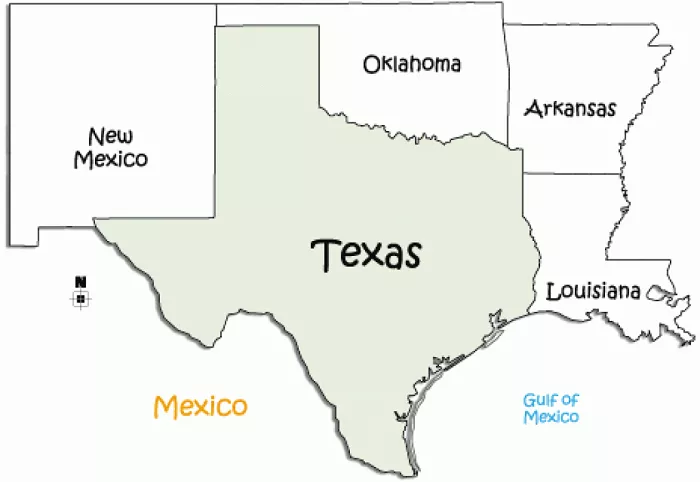When looking at a map of the United States, the state immediately to the left (west) of Texas is New Mexico. This neighboring state shares a long border with Texas and offers a rich tapestry of geography, culture, economy, and ecology. Let’s delve into the multifaceted aspects of New Mexico to understand its unique character.
Geographical Location
New Mexico is located in the southwestern region of the United States. It is bordered by Texas to the east and southeast, Oklahoma to the northeast, Colorado to the north, Arizona to the west, and the Mexican states of Chihuahua and Sonora to the south. The state’s diverse landscapes include mountains, deserts, and forests, making it a land of varied natural beauty.
Major Geographical Features
- Rocky Mountains: The Sangre de Cristo Mountains, part of the southern Rocky Mountains, run through north-central New Mexico, offering high peaks and deep valleys.
- Great Plains: Extending into eastern New Mexico, this area features flat to rolling grasslands and a semi-arid climate.
- Colorado Plateau: Located in the northwest, this region showcases colorful mesas, buttes, and canyons carved by the San Juan River and its tributaries.
- Basin and Range Province: Covering much of southern and central New Mexico, this area is characterized by alternating mountain ranges and flat desert basins.
Historical Context of the Border
The current boundary between Texas and New Mexico has its roots in 19th century territorial disputes:
- Republic of Texas Period (1836-1845): Texas claimed land extending far into present-day New Mexico
- Compromise of 1850: Texas surrendered western lands in exchange for debt relief
- New Mexico Territory (1850-1912): The area west of Texas became federally administered
- Statehood (1912): New Mexico entered the Union with its current borders
Native American Influence
The state is home to 23 different Native American tribes, including the Navajo, Pueblo, and Apache. These tribes have preserved their traditions, languages, and customs, contributing significantly to the state’s cultural fabric.
Hispanic Heritage
Having been a Spanish territory before becoming part of Mexico and eventually the United States, New Mexico retains a strong Hispanic influence. This is evident in its architecture, cuisine, and festivals. Notably, some residents in isolated villages still speak a form of 16th-century Spanish.
Major Ecosystems
- Alpine-Conifer: Found in the high elevations of the northern mountains, supporting species like black bears and elk.
- Desert and Basin: Dominated by the Chihuahuan Desert in the south, home to unique flora like yuccas and agaves, and fauna such as roadrunners and rattlesnakes.
- Juniper-Scrub: Common in lower mountain slopes and foothills, characterized by juniper and pinyon pine woodlands.
- Plains-Mesa: Encompasses the eastern grasslands, providing habitat for pronghorn antelope and prairie dogs.
- Riparian: Areas along rivers and streams, such as the Rio Grande, supporting cottonwood forests and diverse bird species.
Biodiversity
The state’s diverse habitats are home to over 500 species of birds and a variety of mammals, reptiles, and amphibians. Efforts are ongoing to conserve endangered species like the Mexican gray wolf and the Rio Grande silvery minnow.
Cultural and Economic Connections Between Texas and New Mexico
The proximity of Texas and New Mexico has fostered significant cultural exchange and economic interdependence:
Economic Ties
Energy Production:
-
- Both states are major oil and gas producers
- Shared infrastructure in the Permian Basin
- Cross-border workforce in energy sector
Agriculture:
-
- Similar crops (cotton, pecans, chile peppers)
- Shared water resources (Pecos River, Rio Grande)
- Livestock trade between regions
Tourism:
-
- Texas visitors to New Mexico ski resorts
- New Mexico visitors to Texas coastal destinations
- Shared heritage tourism (Route 66, Spanish colonial sites)
Cultural Exchange
Culinary Influences:
-
- Blend of Tex-Mex and New Mexican cuisines
- Shared love of barbecue traditions
- Chile pepper cultivation in both states
Artistic Connections:
-
- Santa Fe and Marfa as art destination hubs
- Cross-pollination of musical traditions
- Film industry connections (Austin and Albuquerque)
Demographic Ties:
-
- Significant Hispanic populations in both states
- Shared Native American heritage (Apache, Comanche)
- Migration patterns between border regions
Conclusion
New Mexico, the state to the left of Texas, is a land of remarkable diversity and rich heritage. From its varied landscapes and ecosystems to its vibrant cultural tapestry and multifaceted economy, New Mexico offers a unique and enriching experience that reflects the confluence of its historical roots and natural beauty.

